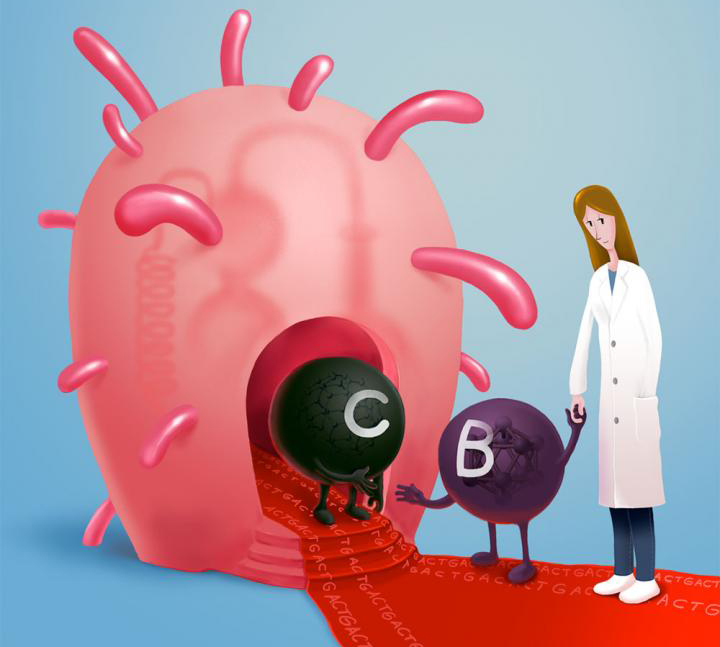As awesome as Nature’s molecular machinery may be, it can’t accomplish many of the tasks routinely carried out by chemists. For example, chemists play with chemical bonds unknown to biology. Yet chemists shouldn’t be complacent. They may find themselves outpaced by living systems engineered to synthesize compounds that were never produced outside laboratories.
By pitting an engineered bacterial process against a conventional chemical synthesis, a team of scientists based at the California Institute of Technology set up a scientific version of the legendary contest that finished John Henry. The Caltech scientists, led by Frances Arnold, the Linus Pauling Professor of Chemical Engineering, Bioengineering and Biochemistry, engineered bacteria to generate an organoborane. Then the scientists showed that the bacteria produced organoboranes 400 times faster than ordinary chemistry.
This feat of synthetic biology marks the first time that bacteria have formed chemical bonds between boron and carbon. Before now, such boron–carbon bonds came only from the laboratories of chemists and could not be produced by any known life form.
Details of the living borylation technology appeared November 29 in the journal Nature, in an article entitled “Genetically Programmed Chiral Organoborane Synthesis.” This article describes the “discovery, evolution and generalization of a fully genetically encoded platform for producing chiral organoboranes in bacteria.” It recalls work accomplished by Arnold’s team last year, work in which bacteria were engineered to produce molecules with silicon–carbon bonds, called organosilicon compounds.
“Escherichia coli cells harbouring wild-type cytochrome c from Rhodothermus marinus (Rma cyt c) were found to form carbon–boron bonds in the presence of borane–Lewis base complexes, through carbene insertion into boron–hydrogen bonds,” wrote the article’s authors. “Directed evolution of Rma cyt c in the bacterial catalyst provided access to 16 novel chiral organoboranes.”
To coax the bacteria into making boron-containing compounds, the scientists used a method pioneered by Arnold in the early 1990s called directed evolution, in which enzymes are evolved in a lab to perform desired functions—such as creating chemical bonds that aren't found in the biological world. As was done in the previous silicon-based research, the scientists started with a common protein called cytochrome c—but with a variant naturally found in bacteria living in Icelandic hot springs.
The scientists mutated the DNA that encodes the protein and then put the mutated DNA sequences into thousands of bacterial cells to see whether the resulting bacteria could create the desired boron–carbon bonds. The DNA of successful mutant proteins was then mutated again, and the cycle was repeated until the bacteria making the proteins were highly proficient at assembling the boron–carbon compounds.
“Evolved in the context of whole-cell catalysts, the proteins were more active in the whole-cell system than in purified forms,” the Nature article noted. “This study establishes a DNA-encoded and readily engineered bacterial platform for borylation; engineering can be accomplished at a pace that rivals the development of chemical synthetic methods, with the ability to achieve turnovers that are two orders of magnitude (over 400-fold) greater than those of known chiral catalysts for the same class of transformation.”
By using biology instead of synthetic processes, the researchers can potentially make the chemical compounds in “greener” ways that are more economical and produce less toxic waste, according to Arnold.
“We have given life a whole new building block that it did not have before,” said Arnold, who is also the director of the Donna and Benjamin M. Rosen Bioengineering Center. “This is just the beginning. We've opened a new space for biology to explore, a space that includes useful products invented by humans.”
Although boron is not an element most people hear about every day, its contribution to chemistry is tremendous. It is, says one of Arnold’s postdocs, Jennifer Kan, Ph.D., one of chemistry’s unsung heroes. “We are excited to add this element to the synthetic biology toolbox for the first time,” remarked Kan.
Boron, which comes from the mineral borax, sits just to the left of carbon on the periodic table. It is a common ingredient found in composite materials and in fertilizers. It's also an essential nutrient of plants, and recent research from NASA's Curiosity rover showed that it is present on Mars, a sign of possible habitable conditions.
The Nature article indicates that the Caltech scientists' living borylation platform is “tunable.” That is, the platform incorporates a biocatalyst that can be tuned to provide either enantiomer of an organoborane product. According to the scientists, this biocatalyst, the cytochrome c–containing enzyme that was evolved in the current study, can provide a 99:1 enantiomeric ratio and 100% chemoselectivity.


